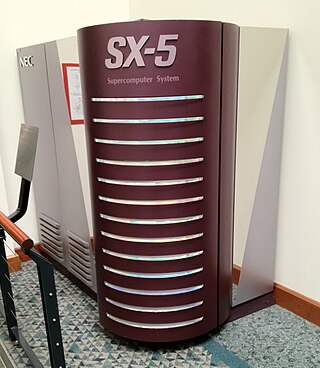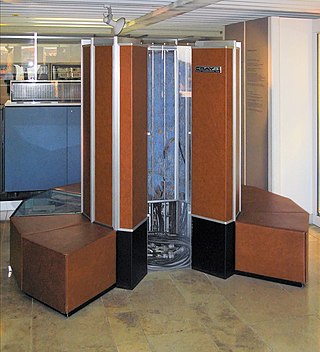
The Cray-1 was a supercomputer designed, manufactured and marketed by Cray Research. Announced in 1975, the first Cray-1 system was installed at Los Alamos National Laboratory in 1976. Eventually, eighty Cray-1s were sold, making it one of the most successful supercomputers in history. It is perhaps best known for its unique shape, a relatively small C-shaped cabinet with a ring of benches around the outside covering the power supplies and the cooling system.

Convex Computer Corporation was a company that developed, manufactured and marketed vector minisupercomputers and supercomputers for small-to-medium-sized businesses. Their later Exemplar series of parallel computing machines were based on the Hewlett-Packard (HP) PA-RISC microprocessors, and in 1995, HP bought the company. Exemplar machines were offered for sale by HP for some time, and Exemplar technology was used in HP's V-Class machines.
The Advanced Scientific Computer (ASC) is a supercomputer designed and manufactured by Texas Instruments (TI) between 1966 and 1973. The ASC's central processing unit (CPU) supported vector processing, a performance-enhancing technique which was key to its high-performance. The ASC, along with the Control Data Corporation STAR-100 supercomputer, were the first computers to feature vector processing. However, this technique's potential was not fully realized by either the ASC or STAR-100 due to an insufficient understanding of the technique; it was the Cray Research Cray-1 supercomputer, announced in 1975 that would fully realize and popularize vector processing. The more successful implementation of vector processing in the Cray-1 would demarcate the ASC as first-generation vector processors, with the Cray-1 belonging in the second.
Cray Inc., a subsidiary of Hewlett Packard Enterprise, is an American supercomputer manufacturer headquartered in Seattle, Washington. It also manufactures systems for data storage and analytics. Several Cray supercomputer systems are listed in the TOP500, which ranks the most powerful supercomputers in the world.

The Cray X-MP was a supercomputer designed, built and sold by Cray Research. It was announced in 1982 as the "cleaned up" successor to the 1975 Cray-1, and was the world's fastest computer from 1983 to 1985 with a quad-processor system performance of 800 MFLOPS. The principal designer was Steve Chen.

The ETA10 is a vector supercomputer designed, manufactured, and marketed by ETA Systems, a spin-off division of Control Data Corporation (CDC). The ETA10 was an evolution of the CDC Cyber 205, which can trace its origins back to the CDC STAR-100, one of the first vector supercomputers to be developed.

The Cray Y-MP was a supercomputer sold by Cray Research from 1988, and the successor to the company's X-MP. The Y-MP retained software compatibility with the X-MP, but extended the address registers from 24 to 32 bits. High-density VLSI ECL technology was used and a new liquid-cooling system was devised. The Y-MP ran the Cray UNICOS operating system.
The VP2000 was the second series of vector supercomputers from Fujitsu. Announced in December 1988, they replaced Fujitsu's earlier FACOM VP Model E Series. The VP2000 was succeeded in 1995 by the VPP300, a massively parallel supercomputer with up to 256 vector processors.

NEC SX describes a series of vector supercomputers designed, manufactured, and marketed by NEC. This computer series is notable for providing the first computer to exceed 1 gigaflop, as well as the fastest supercomputer in the world between 1992–1993, and 2002–2004. The current model, as of 2018, is the SX-Aurora TSUBASA.
Stardent Computer, Inc. was a manufacturer of graphics supercomputer workstations in the late 1980s. The company was formed in 1989 when Ardent Computer Corporation and Stellar Computer Inc. merged.
The SPARC64 V (Zeus) is a SPARC V9 microprocessor designed by Fujitsu. The SPARC64 V was the basis for a series of successive processors designed for servers, and later, supercomputers.
The HITAC S-810 is a family of vector supercomputers developed, manufactured and marketed by Hitachi. The S-810, first announced in August 1982, was the second Japanese supercomputer, following the Fujitsu VP-200 but predating the NEC SX-2. The S-810 was Hitachi's first supercomputer, although the company had previously built a vector processor, the IAP.
The HITAC S-3000 is a former family of vector supercomputers, which was developed, manufactured and marketed by Hitachi. Announced in April 1992, the family succeeded the HITAC S-820. The S-3000 family comprised the low-end and mid-range S-3600 models and the high-end S-3800 models. Unlike Hitachi's previous generations of supercomputers, the S-3000 family was marketed outside Japan.
Numerical Wind Tunnel (数値風洞) was an early implementation of the vector parallel architecture developed in a joint project between National Aerospace Laboratory of Japan and Fujitsu. It was the first supercomputer with a sustained performance of close to 100 Gflop/s for a wide range of fluid dynamics application programs. It stood out at the top of the TOP500 during 1993-1996. With 140 cores, the Numerical Wind Tunnel reached a Rmax of 124.0 GFlop/s and a Rpeak of 235.8 GFlop/s in November 1993.
Duncan's taxonomy is a classification of computer architectures, proposed by Ralph Duncan in 1990. Duncan suggested modifications to Flynn's taxonomy to include pipelined vector processes.

The history of supercomputing goes back to the 1960s when a series of computers at Control Data Corporation (CDC) were designed by Seymour Cray to use innovative designs and parallelism to achieve superior computational peak performance. The CDC 6600, released in 1964, is generally considered the first supercomputer. However, some earlier computers were considered supercomputers for their day such as the 1954 IBM NORC in the 1950s, and in the early 1960s, the UNIVAC LARC (1960), the IBM 7030 Stretch (1962), and the Manchester Atlas (1962), all of which were of comparable power.
FACOM is a trademark used for Fujitsu's computers. The first product is FACOM 100, built in 1954. In May 1990, the brand name of FACOM was abolished and changed to Fujitsu.
The FACOM 128 was a relay-based electromechanical computer built by Fujitsu. Two models were made, namely the FACOM 128A, built in 1956, and the FACOM 128B, built in 1959. As of 2019, a fully working FACOM 128B is still in working order, maintained by Fujitsu staff at a facility in Numazu in Shizuoka Prefecture.
The FACOM 100 was an early electromechanical computer built by Fujitsu in 1954 which used binary-coded decimal arithmetic.
The A64FX is a 64-bit ARM architecture microprocessor designed by Fujitsu. The processor is replacing the SPARC64 V as Fujitsu's processor for supercomputer applications. It powers the Fugaku supercomputer, ranked in the TOP500 as the fastest supercomputer in the world from June 2020, until falling to second place behind Frontier in June 2022.







